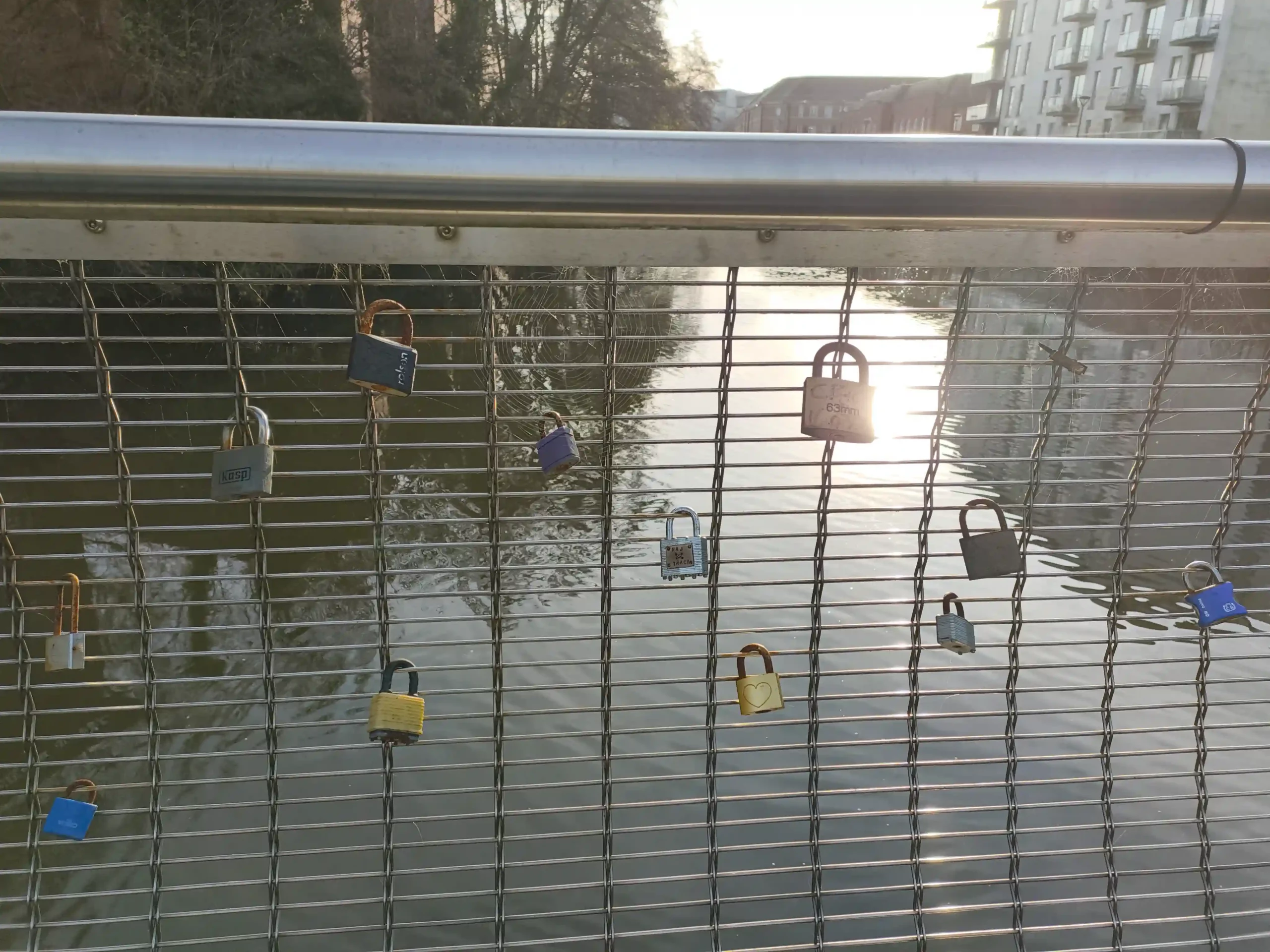
The Cathedral Green Footbridge in Derby is one of the first landmarks you see when you arrive in the city, either by bus, train or car.
It is an imposing feature, not at the level of London Bridge, or say Clifton Bridge close by in Nottingham. But it is still a stunning piece of architecture.
Unbeknown to many, especially passersby, the bridge holds 100 locks plus. And so we went there, to have a look.
WATCH: The love locks at Derby bridge
In Derby, the tradition of love locks is more than just a fad. It has become a significant part of the city’s social and cultural landscape.
The tradition, in which couples attach a padlock to a bridge or fence and throw the key away to symbolise their everlasting love, has captured the imagination of both locals and visitors.
But as the practice continues to grow, so do questions about its impact, both on the city’s bridges and on the tradition itself. So what is it about Derby’s love locks, their history, and their implications for the city?
I went to the Cathedral Green Footbridge where love locks are popular – A journalist’s visit
As a journalist covering stories in Derby, travelling to the Cathedral Green Footbridge is a significant part of my reporting.

The bridge has become synonymous with the love lock tradition in Derby, and it serves as both a physical and symbolic representation of the city’s romantic culture.
Walking to the bridge, I am often struck by how personal and meaningful these locks are to the people who leave them behind.
On my most recent visit, I made my way through Derby’s Cathedral Quarter, admiring the architectural blend of historic buildings and modern shops, which creates a unique atmosphere in the city.
As I approached the footbridge, the first thing that caught my eye was the sea of locks glimmering in the sunlight.
Some were simple and understated, while others had elaborate engravings and stickers, giving each lock its personality.
The bridge itself is narrow, so the locks are closely packed together, creating a patchwork of metal that stretches across the railings.
There is something undeniably charming about the sheer volume of locks; it feels like a collective expression of love and commitment, yet at the same time, the dense accumulation raises questions about the impact on the bridge’s integrity.
During my visit, I spoke with several people who were either adding their locks or simply taking photos.
One couple, who had recently gotten engaged, told me that they had chosen the Cathedral Green Footbridge because it was not only close to their favourite café but also because of its central location.
They had recently made their commitment official and wanted to commemorate the occasion especially.

As I observed the scene, it became clear that the love lock tradition isn’t just about romantic gestures—it’s about creating memories.
For many, the act of placing a lock on the bridge is a once-in-a-lifetime event. However, as I continued to document the growing number of locks, I began to consider the potential consequences of the trend.
Would the locks eventually be removed? Would future couples have to find a new place to leave their mark on Derby?
These questions are likely to come up as the city grapples with the delicate balance between maintaining the charm of the Cathedral Green Footbridge and preserving its structural integrity.
The Cathedral Green Footbridge in Derby represents more than just a bridge. It has become a canvas for personal stories of love, commitment, and shared experiences.
As I continue to report on the love locks phenomenon, it’s clear that this tradition has captured the hearts of many, even as it raises important questions about how we balance sentimentality with preservation.
Love Locks in Derby: Where Are They and How Many Are There?
In Derby, the most famous location for love locks is the Derby footbridge, a pedestrian bridge that spans the A52. The bridge has become a popular spot for couples to leave their mark.
Over the years, the bridge has been heavily adorned with padlocks, each one engraved with the names of couples, dates, and personal messages of love.
While the exact number of locks on the bridge is hard to determine, estimates suggest that there are quite a few, making it one of the most heavily decorated structures in Derby.
Cathedral Green Footbridge: Derby’s Love Lock Hotspot
Where It Is
The Cathedral Green Footbridge in Derby is a well-known landmark, located just a short walk from the heart of the city. This footbridge connects Cathedral Green to the Derby Cathedral Quarter, offering scenic views of the surrounding cityscape. It has become one of the prime locations in Derby for people to place love locks, adding to the romantic atmosphere of the area.
How Many Locks Are There?
The Cathedral Green Footbridge has become the most popular site in Derby for love locks, surpassing even Pride Park Bridge in terms of the number of locks attached.
It’s estimated that over 3,000 locks have been placed over the years at the footbridge. The locks, varying in size and shape, have accumulated in great numbers over the years, creating a visual spectacle that’s particularly noticeable during the warmer months.
The growing number of locks has sparked both admiration and concern from the local community, especially regarding the preservation of the bridge and the aesthetic impact on the area.
Why It Is Popular

The footbridge’s location is one of the primary reasons for its popularity. It sits near the Derby Cathedral, a place of historical and cultural significance, which adds to the romantic symbolism of the love-lock tradition.
Couples are drawn to the bridge for its picturesque setting, making it an ideal spot for sealing their commitment to one another. Additionally, the central location makes it easily accessible, further cementing its status as Derby’s main love-lock destination.
The bridge’s proximity to local landmarks, such as the Derby Museum and Art Gallery, enhances its appeal to both tourists and locals looking to express their love in a unique way.
Could the Locks Be Removed?
As the number of locks on the Cathedral Green Footbridge continues to rise, there are growing concerns about the structural integrity of the bridge.

The weight of the locks, combined with the corrosive effects of weather, could potentially weaken the structure over time.
In recent years, there have been discussions among Derby City Council and heritage organizations about how to manage the growing collection of locks. While there has been no official decision on removal, the council is likely keeping an eye on the situation and may take action if the integrity of the bridge is at risk.
The possibility of relocation, or the introduction of a designated area for the locks, has been considered, much like other cities that have faced similar issues.
Other Places with Love Locks in Derbyshire
While the Derby Footbridge is the most well-known location for love locks in Derby, it is not the only place in Derbyshire where the tradition has taken hold. Bakewell, a picturesque market town in the Peak District, has also become a notable location for love locks.
The Weir Bridge in Bakewell, spanning the River Wye, has been a favourite for couples wishing to commemorate their love. Other locations in Derbyshire, such as Matlock and Chatsworth, have also seen love locks appearing on railings, gates, and other structures, though they have not reached the scale seen in Derby or Bakewell.
The Bridges That Have Been Closed Because of Love Locks
In several cities around the world, love locks have caused significant damage to historic bridges, leading to closures and costly repairs. In Derby, while the tradition has become a part of the city’s identity, it has also raised concerns about the structural integrity of the bridges.
In 2018, the Derby City Council announced that it would be considering the future of love locks on Bakewell Bridge due to the weight of the locks and the risk they posed to the structure.
While no bridges have been closed entirely because of love locks in Derby, other places worldwide, such as Paris and Rome, have experienced closures due to similar issues.
Do Love Locks Damage Bridges?
Yes, love locks can cause damage to bridges. The weight of thousands of padlocks, combined with the pressure from the metal and the corrosive effect of weather, can weaken the structural integrity of a bridge.
In some cases, locks have caused the railing to buckle or become misaligned. In 2014, the famous Pont des Arts bridge in Paris was closed temporarily after the weight of the love locks caused several sections of the railing to collapse.
Similarly, the Lover’s Bridge in Rome also suffered structural damage from the increasing number of locks attached to it.
In Derby, while the issue has not reached the severity of these international cases, the local authorities have been mindful of the potential damage and are taking steps to address it.
Why Do People Put Love Locks?
The tradition of attaching love locks to bridges began in Italy in the early 2000s, when couples would symbolically lock their love to a bridge and throw the key away, signifying their commitment to each other.
The practice was inspired by a novel, I Want You by Federico Moccia, which featured a scene where lovers attached a lock to a bridge as a symbol of their devotion.
Since then, the tradition has spread to cities around the world, with couples flocking to bridges, gates, and even trees to leave their mark.
In Derby, like other cities, the love locks have become a symbol of lasting relationships. Couples attach their locks as a way of celebrating their love and marking significant milestones such as anniversaries, engagements, and weddings.
The act of locking a padlock to a bridge is seen as a simple, yet meaningful gesture of eternal love.
Do Love Locks Actually Work and Keep Lovers Forever?
The idea that love locks can keep lovers together forever is part of the romantic allure of the tradition. However, the idea that a padlock can physically or spiritually bind a couple together is purely symbolic.
There is no scientific evidence to suggest that love locks have any actual impact on a relationship’s longevity. Many relationship experts argue that the health of a relationship depends on mutual trust, communication, and effort, not on the presence of a lock.
Nevertheless, for many couples, the act of placing a lock on a bridge represents a commitment to each other and is a cherished memory.
Where Did the Love Lock Superstition Begin?
The superstition surrounding love locks can be traced back to the novel I Want You by Federico Moccia, published in 2006. In the book, a couple locks a padlock on a bridge in Rome to symbolize their love and throws away the key into the river below.
This scene inspired many couples to replicate the act, and it quickly spread to other cities. The first known love locks in Italy were placed on the Ponte Milvio in Rome, which became a popular spot for couples to participate in the tradition. Over time, the idea of love locks began to spread globally, reaching cities in Europe, Asia, and the Americas.
When Did the Love Lock Tradition Come to Derby?
The love lock tradition arrived in Derby in the early 2010s, following the global spread of the phenomenon. The Pride Park Bridge became the central location for love locks in the city, as couples began to attach locks to the bridge’s railings.
Since then, the tradition has grown in popularity, with thousands of locks adorning the bridge. Local businesses and tourists have embraced the tradition, and the locks have become a beloved feature of the city’s landscape.
Which Places Around the World Have the Most Love Locks?
Some cities around the world have become famous for their love locks. The Pont des Arts in Paris, France, is perhaps the most iconic location for love locks, with millions of locks adorning its railings before they were removed in 2015 due to safety concerns.
Rome’s Ponte Milvio is another major site, with thousands of locks placed by couples from around the world. Other cities such as Seoul, Moscow, and New York have also become hotspots for love locks, with thousands of padlocks attached to bridges, fences, and gates.
Which Places Have Relocated Love Locks and Why?
In response to the damage caused by love locks, some cities have taken action to preserve the tradition while protecting their infrastructure. In Paris, after the collapse of sections of the Pont des Arts bridge, authorities decided to replace the locks with art installations.
The locks were relocated to a nearby Love Lock Wall at the Square de l’Île-de-la-Cité. Similarly, in Moscow, love locks were moved to a designated fence near Vorobyovy Gory (Sparrow Hills) to prevent damage to historical landmarks.
These relocations aim to preserve the cultural significance of love locks while ensuring that the integrity of the structures remains intact.
The love locks at bridges in Derby
The love locks at Derby’s Pride Park Bridge vary in size, colour, and inscription. Some are small and simple, while others are large and elaborately decorated. Couples often engrave their initials, names, or important dates on the locks, making each one unique.
The locks are typically made of brass or steel, and many have colourful tags, stickers, or charms attached to them. Over the years, the accumulation of locks has created a dense, chaotic tapestry of metal, which has become a visual landmark in Derby.
The locks are often placed on the bridge’s railings, with many hanging in clusters, adding to the bridge’s eclectic appearance.
Are There Any Love Locks at Other Bridges in Derby?
There are other locations in Derby where love locks can be found, though none are as prominent. For example, Darley Park, a popular public space in the city, has seen love locks appear on some of its railings and gates.
Similarly, the St. Mary’s Bridge, located in the city centre, has been a spot for a smaller number of locks.
However, Cathedral Green Footbridge remains the main focus for love lock enthusiasts in Derby.
Is It a Crime to Steal Love Locks?
Stealing love locks from a bridge is illegal. Padlocks placed on public property without permission are considered acts of vandalism or theft, and removing them without consent is a crime.
In many cities, including Derby, authorities have warned against the removal of love locks, as it can be damaging to the structure and result in fines or legal action.
While the locks themselves are symbolic, their removal can cause significant harm to the public infrastructure.
Conclusion
The love locks of Derby are more than just a trend; they are a symbol of enduring love and connection. While the tradition has faced criticism due to the potential damage to the city’s bridges, it remains a cherished part of Derby’s landscape.
Whether they are placed as a romantic gesture or simply as a way to mark a special occasion, the love locks continue to draw visitors and couples from all over the world.
However, as the tradition grows, it will be important for the city to find ways to preserve both the spirit of the locks and the integrity of its bridges.




